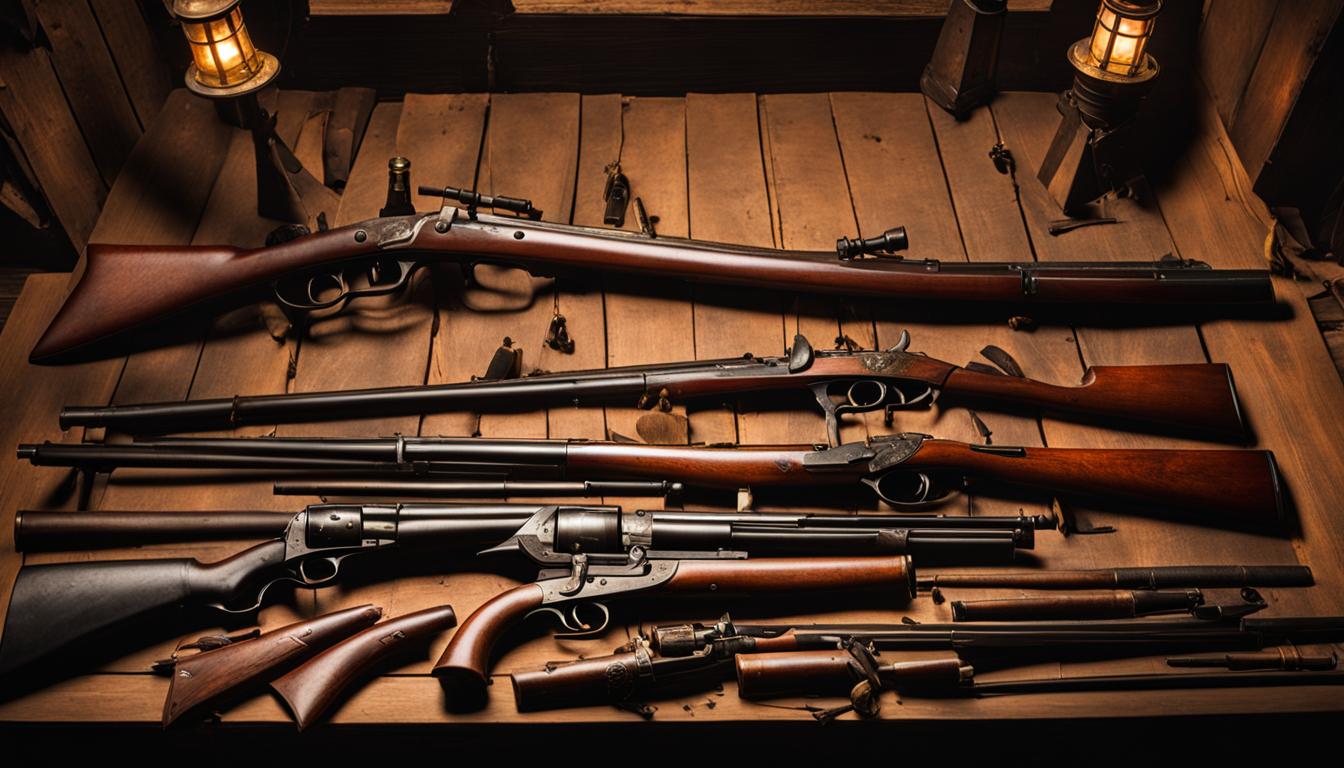Welcome to an in-depth exploration of one of the most pivotal periods in American history – the Civil War. In this article, we will take a comprehensive look at the weapons used during this tumultuous time and their significant impact on warfare. From firearms to artillery, muskets to swords, we will delve into the wide array of Civil War weapons that shaped the course of the conflict.
During the Civil War, firearms played a revolutionary role, transforming the strategies and tactics employed on the battlefield. Artillery brought thundering force, rifles and muskets offered accuracy and range, and swords held their place in close-quarters combat. These weapons not only shaped the outcome of battles but also left a lasting legacy in military history.
Key Takeaways:
- Civil War weapons encompassed firearms, artillery, muskets, rifles, swords, and cannons.
- Firearms revolutionized combat, enhancing accuracy and increasing the lethality of engagements.
- Artillery played a dominant role, inflicting devastating damage and influencing battle outcomes.
- Swords served as both symbols of rank and practical weapons during close-quarters combat.
- The market for Civil War weapons today thrives among collectors and history enthusiasts.
Firearms of the Civil War: Revolutionizing Warfare
Firearms played a crucial role in the Civil War, revolutionizing warfare strategies and tactics. The introduction of more advanced and accurate firearms, such as rifles and muskets, changed the dynamics of the battlefield. The Union and Confederate forces heavily relied on these weapons to gain an advantage over their opponents.
One notable firearm used during the Civil War was the Springfield Model 1861. This rifle, favored by Union soldiers, featured a rifled barrel and a faster reloading mechanism, allowing for more accurate and rapid fire. The Enfield Rifle Musket, on the other hand, was widely used by Confederate troops and proved to be a formidable weapon. The increased effectiveness of these firearms led to higher casualties and greater firepower during engagements.
“Firearms played a crucial role in the Civil War, revolutionizing warfare strategies and tactics.”
The use of firearms in the Civil War marked a turning point in military history. These weapons increased the lethality of engagements and forced armies to adapt their strategies accordingly. Soldiers had to find cover and learn to fight in trenches to protect themselves from the accuracy and rapid fire of these firearms. The introduction and widespread use of firearms also highlighted the importance of skilled marksmanship on the battlefield.
Notable Firearms of the Civil War
Table:
| Firearm | Side | Advantages |
|---|---|---|
| Springfield Model 1861 | Union | – Rifled barrel for increased accuracy – Faster reloading mechanism – Higher rate of fire |
| Enfield Rifle Musket | Confederacy | – Accurate and reliable – Efficient range – Used widely by Confederate soldiers |
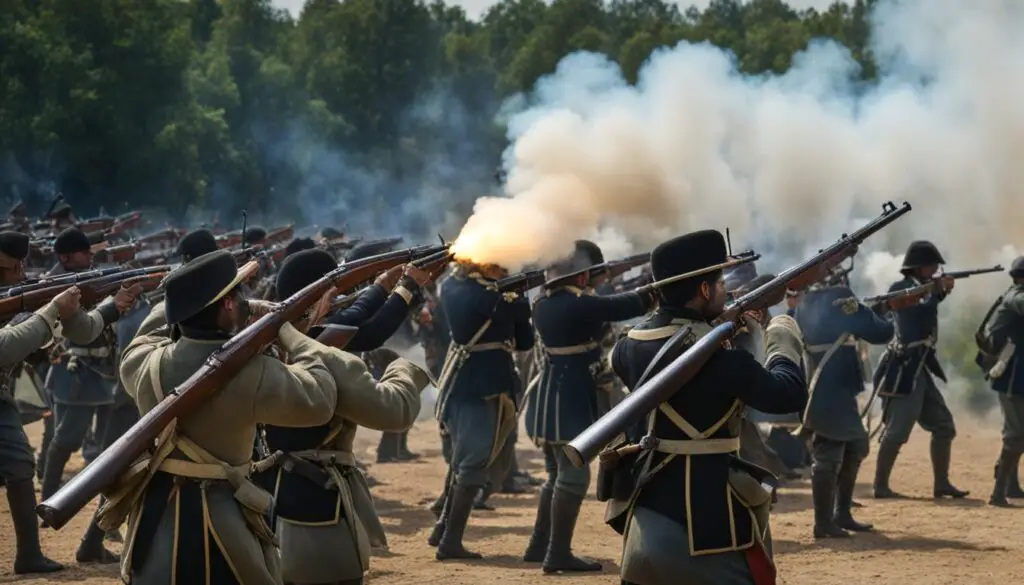
Artillery: The Thundering Force of the Civil War
The Civil War witnessed the immense power and destructive force of artillery on the battlefield. Cannons, both in the Union and Confederate armies, played a pivotal role in shaping the outcome of battles and sieges. The deafening roar and devastating impact of these weapons struck fear into the hearts of soldiers and civilians alike.
The Types of Civil War Artillery
During the Civil War, various types of artillery were employed by both sides. The Union and Confederate forces utilized smoothbore cannons, which fired round shot and shell, as well as rifled artillery, which had grooves inside the barrel for improved accuracy. Some of the most notable types of Civil War artillery included the Napoleon, Parrott, and Whitworth cannons.
Table: Types of Civil War Artillery
| Type | Description |
|---|---|
| Napoleon Cannon | A smoothbore cannon capable of firing a 12-pound round shot or shell. |
| Parrott Cannon | A rifled cannon known for its accuracy and longer range, using a system of iron bands to reinforce the barrel. |
| Whitworth Cannon | A British-made rifled cannon known for its accuracy and innovative hexagonal bore design. |
Quote: “The use of artillery in the Civil War was truly awe-inspiring. The thundering sound of cannons and the devastation they wreaked on the battlefield were unmatched. Soldiers faced not only the horrors of gunfire but also the immense power of these incredible weapons.” – Civil War historian
Today, Civil War cannons hold great historical and collectible value. These artifacts can be found for sale in the antique market, allowing enthusiasts and collectors to own a piece of this turbulent period in American history. Owning a Civil War cannon is not only a testament to the innovation of the time but also a tangible connection to the soldiers who fought on the front lines.
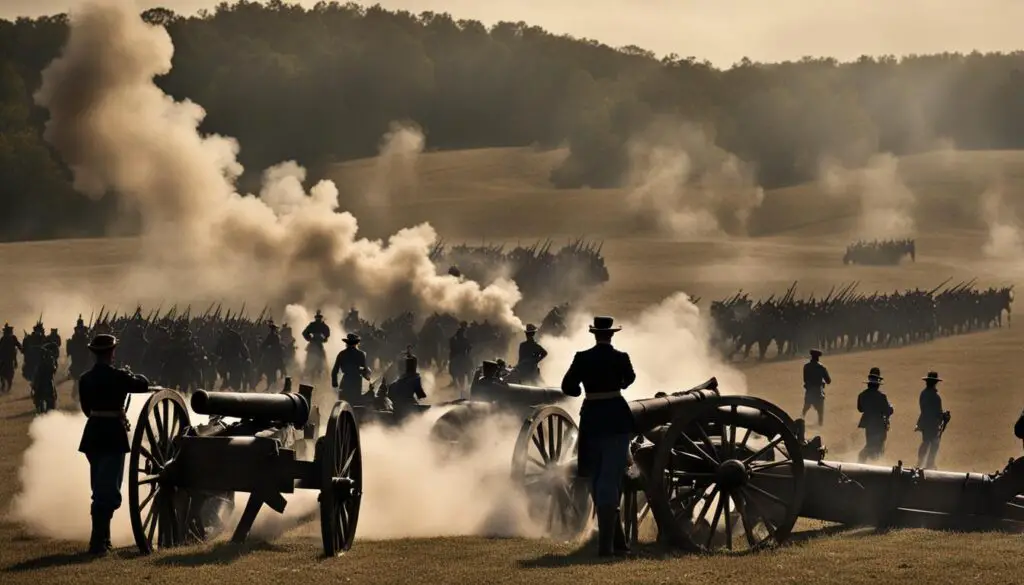
The legacy of Civil War artillery extends beyond its immediate impact on the battlefield. The technological advancements and tactical strategies developed during the war laid the foundation for future artillery systems. The lessons learned from the use of cannons in the Civil War still resonate in modern warfare, shaping the way artillery is utilized in conflicts around the world.
The Impact of Swords in Civil War Combat
Swords played a significant role in combat during the Civil War, serving as both symbols of rank and practical weapons. While the use of swords diminished with the rise of firearms, they still had their place in close-quarters combat and mounted cavalry charges. The Civil War saw officers on both sides carry swords, often with ornate designs and engravings, showcasing their status and authority on the battlefield.
One notable example of a Civil War sword is the Model 1840 Cavalry Saber, commonly used by Union and Confederate cavalrymen. This sword had a curved blade ideal for slashing and thrusting, making it effective in mounted charges and hand-to-hand combat. The Model 1840 Cavalry Saber became a symbol of the fierce and gallant cavalrymen of the era.
Civil War swords continue to captivate collectors and history enthusiasts to this day. These exquisite pieces of weaponry can be found for sale in the antique market. Owning a Civil War sword allows collectors to possess a tangible piece of history, connecting them to the soldiers who fought in this pivotal conflict. These swords serve as a reminder of the bravery and sacrifices made by those who fought during the Civil War.
The Model 1840 Cavalry Saber
| Sword Name | Origin | Blade Length | Description |
|---|---|---|---|
| Model 1840 Cavalry Saber | United States | 35 inches | The Model 1840 Cavalry Saber was the primary sword used by cavalry troops during the Civil War. It had a curved blade design, which allowed for effective slashing and thrusting maneuvers. The sword’s length, typically around 35 inches, made it ideal for mounted charges and close-quarters combat. The Model 1840 Cavalry Saber became a symbol of courage and valor on the battlefield. |
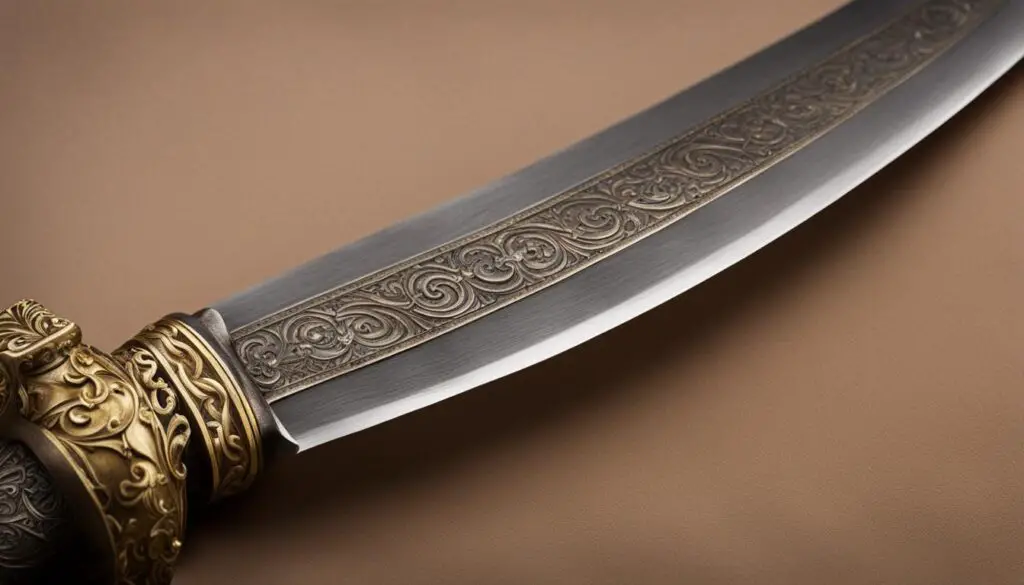
Civil War Weapons: A Market for Collectors
The market for Civil War weapons is thriving among collectors and history enthusiasts. This market offers a unique opportunity to own a tangible piece of history and gain a deeper appreciation for the soldiers who fought during this pivotal time in American history. Authentic Civil War weapons, including firearms, artillery, swords, and other weapons, can be found for sale through antique dealers, auctions, and online platforms.
Collecting Civil War weapons allows enthusiasts to connect with the past and preserve the legacy of these historic artifacts. Each weapon carries its own story, representing the experiences of the soldiers who wielded them. Whether it’s a Civil War musket used by infantrymen or a cavalry sword carried by a mounted officer, these weapons provide a window into the past and offer a glimpse of the challenges and sacrifices faced by those who fought in the Civil War.
When searching for Civil War weapons for sale, collectors can explore a wide range of options. Antique dealers specialize in offering authentic and well-preserved pieces, ensuring the historical accuracy and value of the weapons. Auctions provide an exciting opportunity to acquire rare or unique items through competitive bidding. Online platforms offer convenience and access to a global marketplace, where collectors can find a diverse selection of Civil War weapons from various eras and locations.
| Weapon Type | Estimated Price Range |
|---|---|
| Civil War Musket | $1,000 – $3,000 |
| Civil War Rifle | $2,000 – $5,000 |
| Civil War Artillery | $5,000 – $10,000+ |
| Civil War Sword | $1,500 – $4,000 |
It is important for collectors to be aware of the potential for counterfeit or reproduction items in the market. Due to the high demand for Civil War weapons, some unscrupulous sellers may attempt to pass off replicas as genuine artifacts. It is advisable to research reputable dealers and obtain proper documentation or authentication for any purchase. Working closely with knowledgeable experts and participating in collector communities can also help ensure the authenticity and value of the acquired weapons.
Civil War Armories and Manufacture of Weapons
The Civil War brought about an increased demand for weapons, prompting the establishment of armories and factories dedicated to their production. These armories played a crucial role in supplying both the Union and Confederate armies with the necessary firearms, ammunition, and other weapons. The Springfield Armory and the Harpers Ferry Armory were two notable examples of such facilities.
The Springfield Armory, located in Massachusetts, was a major contributor to the Union’s arsenal during the Civil War. It produced thousands of rifles, including the iconic Springfield Model 1861, which became the standard firearm for Union soldiers. The armory’s efficient manufacturing processes allowed for a steady supply of reliable firearms, reinforcing the Union’s military strength.
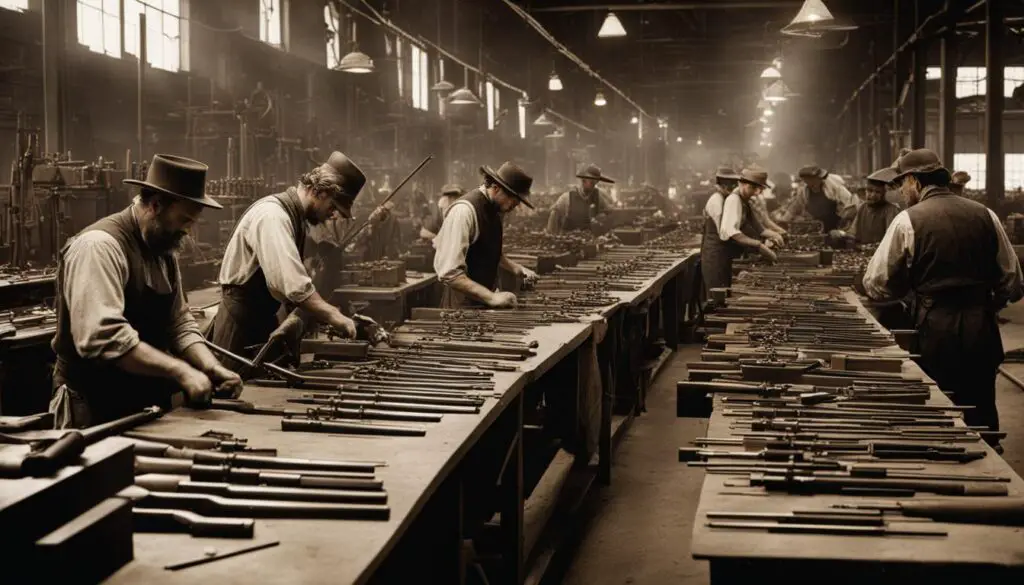
The Harpers Ferry Armory, situated in what is now West Virginia, played a significant role in the early stages of the war. However, the armory was captured by Confederate forces in 1861, resulting in the destruction of much of its equipment and machinery. This loss dealt a significant blow to the Union’s weapon production capabilities. Despite this setback, other armories and factories across the country continued to manufacture weapons to support the war effort.
The establishment of armories and the manufacturing of weapons during the Civil War marked a significant shift in the production of firearms and other weaponry. These facilities not only ensured the availability of weapons but also acted as centers of innovation, as armory personnel and engineers sought to improve upon existing designs. The legacy of these armories and the weapons they produced can still be seen today in the collectible market and the continued fascination with Civil War history.
Technological Advances in Civil War Weapons
The Civil War witnessed significant technological advances in weapons and warfare. These advancements played a crucial role in shaping the outcome of battles and the overall conduct of the war. From improvements in firearms to innovations in artillery and naval warfare, the Civil War marked a turning point in military technology.
Advancements in Firearms
One of the most notable advancements during the Civil War was the widespread use of rifled firearms. Prior to the war, smoothbore muskets were the standard issue for infantry. However, the introduction of rifling, which involved grooves cut into the barrel, significantly improved accuracy and range. Rifled firearms allowed soldiers to engage targets at longer distances and with greater precision, changing the dynamics of battle. The development and adoption of rifling technology played a crucial role in the evolution of warfare.
Innovations in Artillery
Civil War artillery saw several technological advancements that enhanced its effectiveness on the battlefield. The introduction of rifled artillery improved accuracy and range, making cannons more deadly than ever before. The development of more powerful ammunition, such as explosive shells and canister rounds, further increased the destructive power of artillery. These innovations allowed cannons to inflict devastating damage on enemy positions and play a significant role in shaping the outcome of battles.
Revolutionizing Naval Warfare
Ironclad warships were a revolutionary development in naval warfare during the Civil War. The USS Monitor and the CSS Virginia, also known as the Merrimack, were the first ironclads to see combat. These heavily armored ships provided superior protection compared to traditional wooden vessels, rendering them nearly impervious to enemy fire. The introduction of ironclads challenged existing naval strategies and tactics, leading to the modernization of navies worldwide.
Overall, the technological advances in Civil War weapons had a profound impact on the outcome of battles and the future of warfare. They revolutionized both land and naval combat, shaping the way wars were fought for years to come.
Civil War Firearms: Revolutionizing Warfare
Civil War firearms played a pivotal role in revolutionizing warfare strategies and tactics. The introduction of more advanced and accurate rifles and muskets changed the dynamics of the battlefield, enhancing the lethality of engagements. The Springfield Model 1861 and the Enfield Rifle Musket were among the notable firearms used by both Union and Confederate soldiers.
The Springfield Model 1861, produced by the Springfield Armory, was a widely used rifle known for its reliability and accuracy. Its rifled barrel allowed for improved range and precision, making it a formidable weapon on the battlefield. On the Confederate side, the Enfield Rifle Musket, imported from Britain, became a favored choice due to its reliability and long-range capabilities.
“The Springfield Model 1861 and the Enfield Rifle Musket revolutionized combat during the Civil War, enabling soldiers to engage targets with greater accuracy and efficiency. These firearms marked a significant shift from the outdated smoothbore muskets, influencing combat tactics and strategies on both sides of the conflict.”
The advancements in Civil War firearms had a profound impact on the outcome of battles. They allowed soldiers to engage targets from a safer distance, changing the dynamics of warfare. The increased range and accuracy of these firearms challenged traditional battle formations and led to the adoption of new strategies to counter the deadly effectiveness of the rifles and muskets.
The Impact of Civil War Firearms
Not only did Civil War firearms revolutionize the way wars were fought, but they also left a lasting impact on military history. The development and widespread use of these advanced firearms laid the groundwork for future advancements in weaponry. The lessons learned from the Civil War firearms’ effectiveness influenced the design and production of firearms in subsequent conflicts, shaping the evolution of modern warfare.
Table: Comparison of Civil War Firearms
| Firearm | Origin | Advantages | Disadvantages |
|---|---|---|---|
| Springfield Model 1861 | United States | Reliability, accuracy, rang | Long reload time |
| Enfield Rifle Musket | United Kingdom | Reliability, long range | Difficulty in obtaining ammunition |
The comparison table above highlights the advantages and disadvantages of two prominent Civil War firearms. While the Springfield Model 1861 offered reliability and accuracy, its long reload time could put soldiers at a disadvantage in intense engagements. On the other hand, the Enfield Rifle Musket’s long-range capabilities were offset by challenges in obtaining ammunition. These variations in performance influenced soldiers’ choices and had a significant impact on the strategies employed during the war.
The legacy of Civil War firearms can still be seen today in the advancement of weapon technology and the ongoing fascination with collecting authentic artifacts from this pivotal period in American history. These firearms were more than just tools of war; they were symbols of innovation and determination in a nation divided.
Civil War Artillery: Powerful Weapons on the Battlefield
Artillery played a crucial role in the Civil War, unleashing devastating firepower on the battlefield. Cannons such as the Napoleon and the Parrott gun were capable of inflicting massive damage, causing chaos and destruction among the opposing forces. The sheer power and range of these weapons made them a formidable force, capable of turning the tide of battle.
The psychological impact of artillery cannot be underestimated. The thunderous sound of cannons firing and the sight of deadly projectiles hurtling through the air struck fear into the hearts of soldiers, often causing panic and disarray. The psychological advantage gained from the fear-inducing power of artillery cannot be overstated.
“The roar of the cannons was deafening, the ground shook beneath our feet. We knew the enemy was close, and the sight of the cannonballs flying towards us filled us with dread. It was a battlefield like no other.” – Civil War veteran
Artillery was not only used in direct combat but also played a significant role in sieges and strategic positions. The ability to fire at long distances allowed cannons to weaken defenses and force enemy troops to retreat. In battles such as Gettysburg and Antietam, artillery played a pivotal role in the outcome of the engagements, shaping the course of the war.
The Table: Comparative Analysis of Civil War Cannons
| Cannon | Caliber | Range | Weight |
|---|---|---|---|
| Napoleon | 12-pounder | 1,600 yards | 1,227 lbs |
| Parrott | 10-pounder | 2,000 yards | 890 lbs |
| Howitzer | 12-pounder | 900 yards | 1,340 lbs |
Note: This table provides a comparative analysis of three commonly used Civil War cannons. The Napoleon cannon was known for its versatility and effectiveness, while the Parrott cannon offered greater range. The Howitzer, on the other hand, was designed for indirect fire and close support.
Summary:
Artillery was a potent force on the Civil War battlefield, capable of inflicting devastating damage and instilling fear in the hearts of soldiers. Cannons such as the Napoleon and the Parrott gun unleashed powerful projectiles that could reach targets at great distances. The psychological impact of artillery, along with its tactical effectiveness, made it a vital component of Civil War warfare. The comparative analysis of Civil War cannons highlights the different capabilities and characteristics of these weapons, showcasing their importance in shaping the outcome of battles.
The Legacy of Civil War Weapons
The weapons used during the Civil War had a profound impact on the course of the conflict and left a lasting legacy in the history of warfare. From firearms to artillery and swords, these weapons revolutionized combat and shaped the strategies and tactics employed by both Union and Confederate forces. The legacy of these weapons can still be seen today, both in their historical significance and the market for antique collectibles.
The Impact of Civil War Weapons
The introduction of firearms, such as rifles and muskets, played a crucial role in changing the nature of warfare during the Civil War. These weapons provided increased accuracy and range, allowing soldiers to engage enemies from greater distances. The lethal effectiveness of these firearms led to a higher casualty rate and influenced the tactics employed on the battlefield. The impact of Civil War firearms can be seen in the evolution of military strategies and the development of future weapons.
Artillery was another significant aspect of Civil War weaponry. The powerful cannons used by both sides had a devastating impact on the battlefield. The sheer destructive force of these weapons was capable of causing significant damage to fortifications and infantry formations. The psychological impact of artillery fire added another layer of terror to the already gruesome reality of war. The legacy of Civil War artillery can be seen in the continued development of artillery technology and the role it plays in modern warfare.
The Market for Civil War Weapons
Civil War weapons have become highly sought-after collectibles in the market. These artifacts provide a tangible connection to the soldiers who fought in the war and offer a glimpse into the past. Collectors and history enthusiasts value these weapons for their historical significance and their ability to tell stories of bravery and sacrifice. The market for Civil War weapons allows individuals to own a piece of history and preserve the memory of those who fought in this pivotal conflict.
Overall, the legacy of Civil War weapons is one of innovation, destruction, and historical significance. These weapons revolutionized warfare and left a lasting impact on military history. Whether through the advancements in firearms technology, the power of artillery, or the collectible market, the legacy of Civil War weapons continues to captivate and educate people today.
| Civil War Firearms | Civil War Artillery | Civil War Swords |
|---|---|---|
| Rifles | Cannons | Swords |
| Muskets | Smoothbore cannons | Officers’ swords |
| Pistols | Rifled artillery | Cavalry sabers |
“The weapons used during the Civil War transformed warfare and left an indelible mark on military history.” – Civil War historian
Conclusion
In conclusion, the weapons used during the Civil War had a profound impact on the outcome of battles and the overall conduct of the war. Firearms such as muskets and rifles revolutionized warfare, allowing for more accurate and rapid fire. Artillery, with its devastating firepower, played a dominant role on the battlefield, while swords served as both symbols of rank and weapons in close-quarters combat.
Today, the market for Civil War weapons continues to thrive among collectors and history enthusiasts. Authentic firearms, artillery, swords, and other weapons can be found for sale, allowing enthusiasts to own a tangible piece of history. Collecting these weapons not only provides a deeper appreciation for the soldiers who fought during this pivotal time in American history but also serves as a connection to the past.
Furthermore, the legacy of Civil War weapons can still be seen today. The technological advancements made during this time had a lasting impact on military history, influencing the development of weapons in future conflicts. The introduction of firearms, the advancements in artillery, and the prominence of swords showcased the evolving nature of combat and forever changed the way wars were fought.
FAQ
What types of weapons were used during the Civil War?
The weapons used during the Civil War included firearms such as muskets and rifles, artillery cannons, swords, and canons.
What firearms were commonly used in the Civil War?
The Union and Confederate forces relied heavily on muskets and rifles, such as the Springfield Model 1861 and the Enfield Rifle Musket.
How did firearms revolutionize warfare during the Civil War?
The introduction and widespread use of firearms marked a turning point in military history, allowing for more accurate and rapid fire and increasing the lethality of engagements on the battlefield.
What role did artillery play in the Civil War?
Artillery was a dominant force during the Civil War, with both the Union and Confederate armies utilizing cannons of various types. They provided devastating firepower and played a significant role in battles such as Gettysburg and Antietam.
Are there Civil War weapons available for sale today?
Yes, there is a thriving market for Civil War weapons among collectors and history enthusiasts. Authentic weapons can be found for sale through antique dealers, auctions, and online platforms.
What is the significance of Civil War swords?
Swords served as both symbols of rank and practical weapons during the Civil War. They played a role in close-quarters combat and mounted cavalry charges.
Where were Civil War weapons manufactured?
The Civil War saw the establishment of various armories and factories dedicated to manufacturing weapons. Armories such as the Springfield Armory and the Harpers Ferry Armory produced thousands of muskets and rifles to equip the troops.
What technological advances were made in Civil War weapons?
The Civil War witnessed significant technological advances in weapons and warfare, including rifling in firearms for improved accuracy, the development of ironclad warships for naval combat, and innovations in artillery and ammunition.
Which firearms had a lasting impact on military history?
Several firearms played a prominent role in the Civil War and left a lasting impact on military history, including the Springfield Model 1861 and the Enfield Rifle Musket.
What is the legacy of Civil War weapons?
The weapons used during the Civil War played a significant role in shaping the outcome of battles and the overall conduct of the war. They continue to captivate collectors and serve as a tangible connection to the soldiers who fought in this pivotal conflict.
Source Links
- https://podcasts.apple.com/us/podcast/military-history-plus/id1696512673
- https://www.battlefields.org/learn-about-civil-war-weekend
- https://kansaspress.ku.edu/9780700632275
